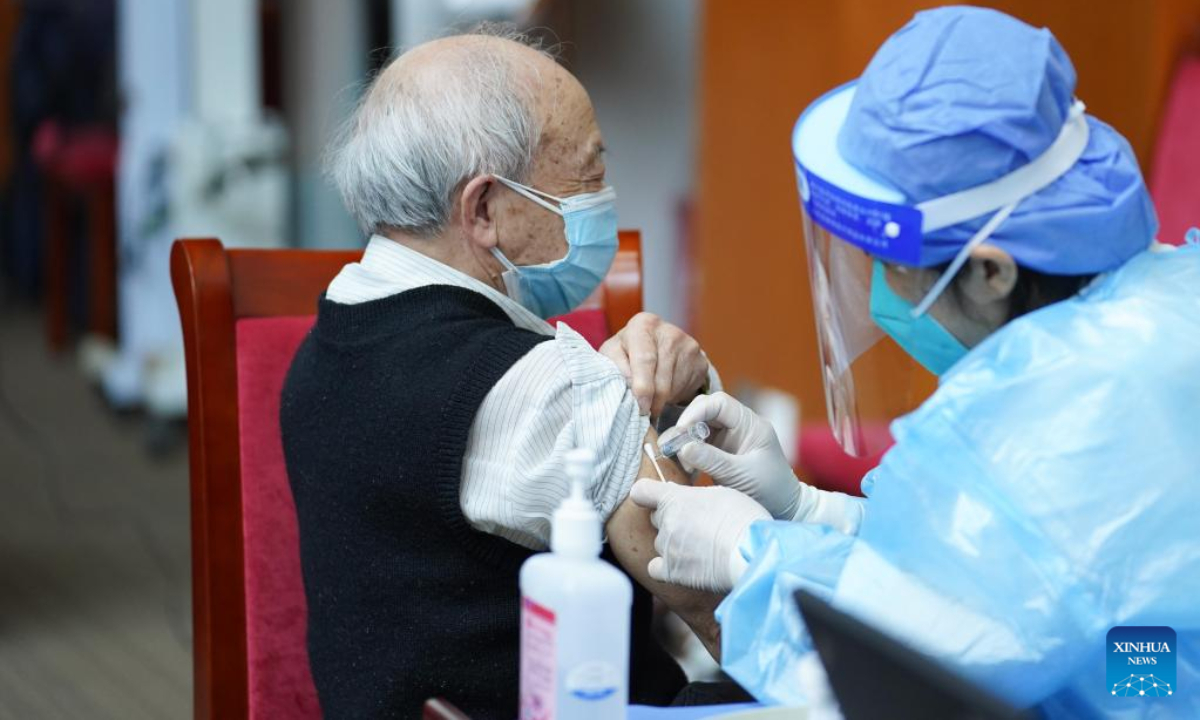
A medical worker injects COVID-19 vaccine for a senior citizen in Dongcheng District of Beijing, capital of China, April 18, 2022. Photo:Xinhua
International and domestic monitoring has confirmed that the virulence and pathogenicity of the Omicron variant and its evolutionary branches are significantly reduced compared with the original COVID-19 strain and Delta variants, several Chinese respiratory experts have confirmed.
Omicron has strong transmission capability which is faster than the original strains. People infected with Omicron mainly show the upper respiratory symptoms, such as moderate or low fever, throat discomfort and cough, Tong Zhaohui, a respiratory and critical illness expert and director of the Beijing Institute of Respiratory Medicine, told the China Central Television.
Based on the data collected across the country, the number of asymptomatic carriers and patients experiencing mild syndromes accounts for more than 90 percent total cases, and with the proportion of severe and critical cases only a small fraction, Tong said. "I was also on the front line in Beijing recently, and have been to designated hospitals for ward rounds and consultations. There were only three or four cases who needed to be hospitalized and used ventilators due to COVID-19," Tong said.
The proportion of severe illness and death caused by the Omicron variant was significantly lower, which was not only a characteristic of the Omicron variant, but also related to the improved immunization of the population and the country's active epidemic prevention efforts, Tong noted.
"Compared with the 2009 global influenza pandemic, the proportion of Omicron variant causing pneumonia or severe or critical illness is relatively low," Tong noted.
Experts in Guangzhou also echoed the sentiment that Omicron was not as much of a risk to a majority of the population.
More than 170,000 local cases have been reported in Guangzhou, South China's Guangdong Province in latest round of epidemic, about 90 percent of which are asymptomatic and no deaths have been reported.
"Amid the outbreak of the original COVID-19 virus and Delta strains, more than half of the infected individuals developed pneumonia, and even more than 60 percent of the patients had different pulmonary manifestations. More than 90 percent of the outbreaks have been asymptomatic and mild cases, with few cases of pneumonia and even fewer cases of severe pneumonia," Tang Xiaoping, director of Research Institute of Infectious Diseases in Guangzhou, told the Xinhua News Agency.
Analyzing a designated hospital in Guangzhou for example. The Guangzhou 8th People's Hospital has received more than 5,000 cases since October 22, including more than 500 people over the age of 60. Among them, two cases were diagnosed as severe cases, said the report.
Li Yimin, an expert from the critical care division in Guangzhou Institute of Respiratory Health, said that the proportion of seriously ill patients is not too much in this wave of outbreak, and most of the critical patients indicated aggravating original underlying diseases, which can be gradually recovered after active treatment.
Zhang Zhongde, vice president of the Guangzhou University of Chinese Medicine, told Xinhua that the core pathogenesis of the outbreak in Guangzhou was quite different from the original strain spread at the beginning of the epidemic and also different from the Delta strain that spread seriously in Guangzhou in 2021.
It takes generally five to seven days for asymptomatic carriers, mild or ordinary patients, to become negative following recovery, with some patients remaining positive for about 11 days, but most returning to negative in around five days, Zhang said.
Another expert Zhang Wenhong, head of the Center for Infectious Diseases with the Shanghai-based Huashan Hospital of Fudan University, also said during a conference held during the weekend that international experience shows that the fatality rate from COVID-19 will be very low given adequate protection for vulnerable populations, according to Science and Technology Daily.
Chinese Vice Premier Sun Chunlan on November 30 said that China has effectively dealt with uncertainty linked to the epidemic with a
consistent strategy and flexible measures. Sun called for effective practices for fighting the virus in communities while optimizing response measures in the following day.




